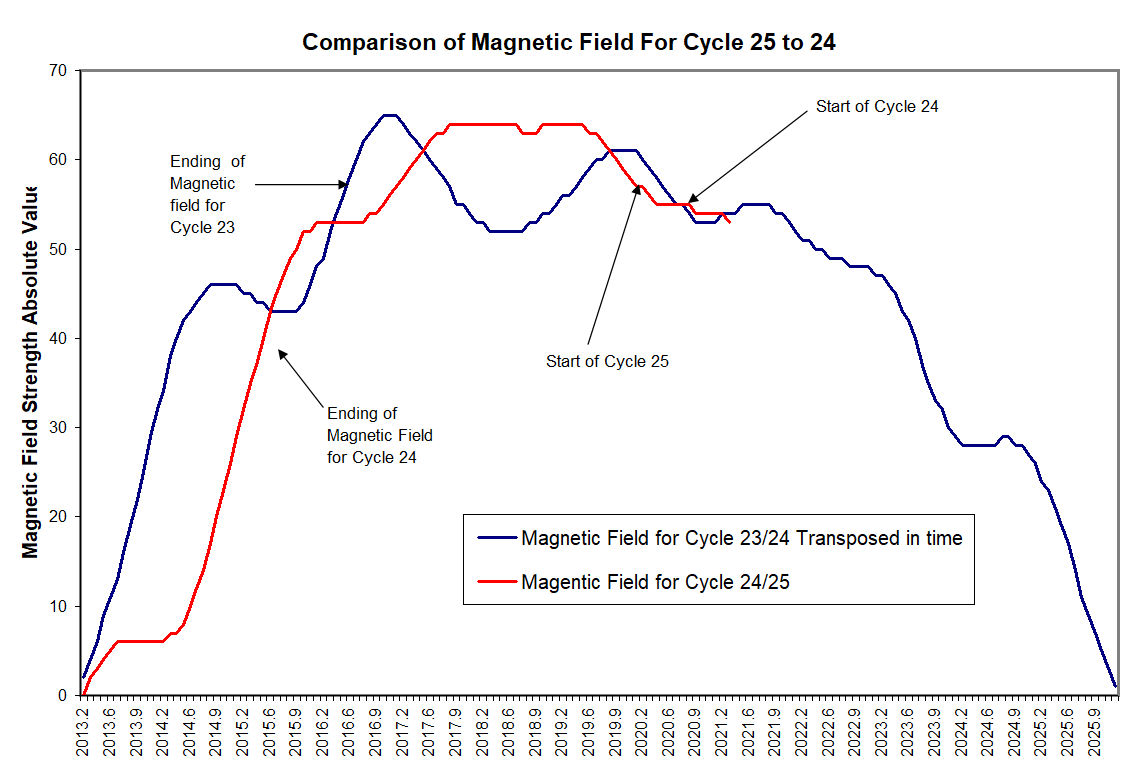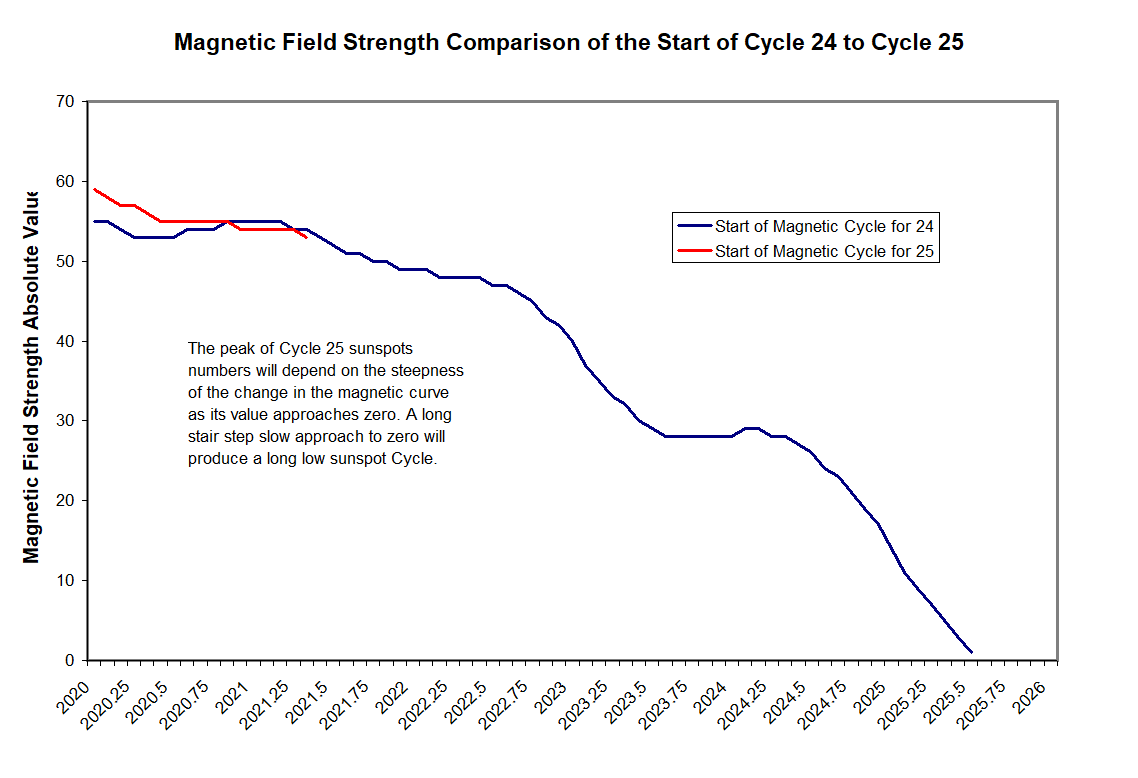The last time we took a look at Leif Svalgaard’s SC25 prediction in 2018, he was predicting a peak amplitude of around 140SSN in 2024 according to the plot or (giving himself more latitude) “SC25 will be somewhere between SC24 and SC20, provided the Polar Field Precursor Relationship holds.”
This has been modified in his latest presentation on the subject. The peak amplitude has been revised downwards to 128+/-10SSN.

Our own prediction, made in 2013 by Rick Salvador is still looking good at the moment. Rick’s model doesn’t allow any ‘dwell’ at solar minimum, and runs about a year early. It predicted a cycle 24 peak of around 100SSN, compared to the actual of 116SSN. It’s possible it’ll underestimate cycle 25 too. Within the next few years, we’ll know the facts.

Looking at the latest TSI data from the TSIS-1 NASA mission, it’s hard to tell what will happen next, but after an initial spurt of activity at the end of November last year, solar activity has quietened down again for now. The F10.7 radio flux and SSN data from Solen.info also show low activity.


The Sun’s changing activity is hard to model. There is a vast range of predictions out there from many researchers using different methods. Leif’s falls in the middle of the range; ours falls at the low end. Scott Mcintosh’s is at the high end.
As they say on BANZAI! – Place bets now!







I love it when Svalgaard is proved wrong and has to make a revision, he is such an arrogant SOB.
He talks as if He and Scientists know everything about the Earth’s and the Sun’s history when they are actually guessing, because they were not actually there and do not possess time machines.
I had many disagreements with on WUWT.
Well to be fair to Leif, he hasn’t revised it by much, and it is in line with his methodology, the solar polar fields evolved further after his 2018 prediction. I don’t argue with him any more, but he is still helpful if I email him to ask for information.
Who cares?
Everybody needs to focus on the portion of incident solar that is absorbed in the atmosphere, and see how — or IF, at all — it varies.
Of course, you have to make sure you are measuring that portion accurately.
The incident solar absorbed in the atmosphere is relatively small (~20%), and the energy is lost back to space on a diurnal basis. What’s really important is the amount of incident solar absorbed by the high heat capacity overturning ocean, and that depends on changes in cloud albedo. In turn, albedo variation is mainly a function of solar variation. That’s why I care about trying to forecast solar variation.
Ned Nikolov has been working on albedo. Hopefully, I’ll get the chance to discuss it with him when I visit Colorado in August.
Another SC 25 prediction, with the benefit of the cycle having already started of course…
Published: 19 April 2021
Prediction of Amplitude and Timing of Solar Cycle 25
Partha Chowdhury, Rajmal Jain, P. C. Ray, Dipali Burud & Amlan Chakrabarti
We study the geomagnetic activity Ap-index in relation to sunspot number and area for the interval covering Solar Cycles 17 to 24 (1932 – 2019), in view of the availability of data for the Ap-index from 1932 on, in order to predict the amplitude of Sunspot Cycle 25. We examine the statistical relationship between sunspot-maximum amplitude and Ap-index, and similarly that between sunspot area and Ap-index. We apply the χ2-test for the best fit between two parameters and obtain the correlation coefficient. We also derive the standard deviation for the error limits in the predicted results.
Our study reveals that the amplitude of the Sunspot Cycle 25 is likely to be ≈100.21±15.06 and it may peak in April 2025±6.5 months.
https://link.springer.com/article/10.1007/s11207-021-01791-8
Solar cycle 24-25 has already passed 23-24 in Wikipedia’s ‘alternative’ table which ‘is instead divided into (unofficial) cycles starting and ending with a maximum, to give a better feel for the number of spotless days associated with each minimum’:
Solar Cycles……Start” (Max.)…Spotless days
Solar cycle 23-24….2001-11…………817
Solar cycle 24-25….2014-04…………835 (May 15 2021)
https://en.wikipedia.org/wiki/List_of_solar_cycles
Below that on the Wiki page is a direct comparison of SC 24 and 25 progressions, with SC 25 clearly faltering at present (although the most recent data is provisional).
Note: the previous four entries in the table are in the range 227-309, about 1/3rd of the two above.
So far so good; and no GSM.
It’s a fun time to be in the solar prediction game. Literally anything could happen over the next year. SC25 could take off like a rocket and leave our prediction in the weeds, or the Sun could get really sulky and stop showing spots altogether, as it did in the Maunder minimum (notwithstanding the lower quality optics of the day). Or anything in between.
We need to be ready to accept the (critically examined) data, wherever it leads us.
Leif knows this, which is why he qualifies his prediction with caveats such as “provided the Polar Field Precursor Relationship holds.”
Amen, Tallbloke. We have been skeptical of claims of impending doom all along. Now we will watch and learn.
I suspect the sun is not forecastable, at least not at our current level of knowledge. Its fun to try but that’s about it.
The suns magnetic field and the phenomena of sunspots are temporal coherent somewhat like the sine cosine relationship where each is the derivative of the other. One can get an idea of the direction and magnitude of the sunspot number from the change in the slope of the magnetic field. One can also approximate the sunspot number by relating the magnitude of the magnetic field to the change in temporal change in slope of the sunspot number and then integrating the result to reproduce the sunspot curve from the magnetic curve. This is useful because it puts a limit on the near future sunspot number unless the magnetic field does something completely strange. (The near future being the next 5 years.) That limit for the sunspot number today is probably 70 plus or minus 30.
The alternative calculation is to find the relationship between the temporal magnetic field change and the magnitude of the Sunspot number and then calculate the sunspot number from the change in the magnetic field strength. When time permits I will post graphs with the equations for both methods.
Reblogged this on Climate Collections.
Aequitas, this sounds interesting, thanks for posting.
In the graphs above, why don’t TSI and F10.7 flux go up with sunspot numbers in April like they did in November last year? I thought they were supposed to correlate well.
OB: That’s one to keep an eye on. They do correlate well in general, but it’s not perfect. Here’s a plot of monthly TSI vs SSN from the last minimum and start of SC24. After the start of the last cycle TSI jumped up ahead of Sunspot number. This time it’s the reverse,, at the moment.
This is the of course the sine cosine type relationship of the Polarity Sunspots to the Polar Magnetic Field strength. I will get to the calculations later.
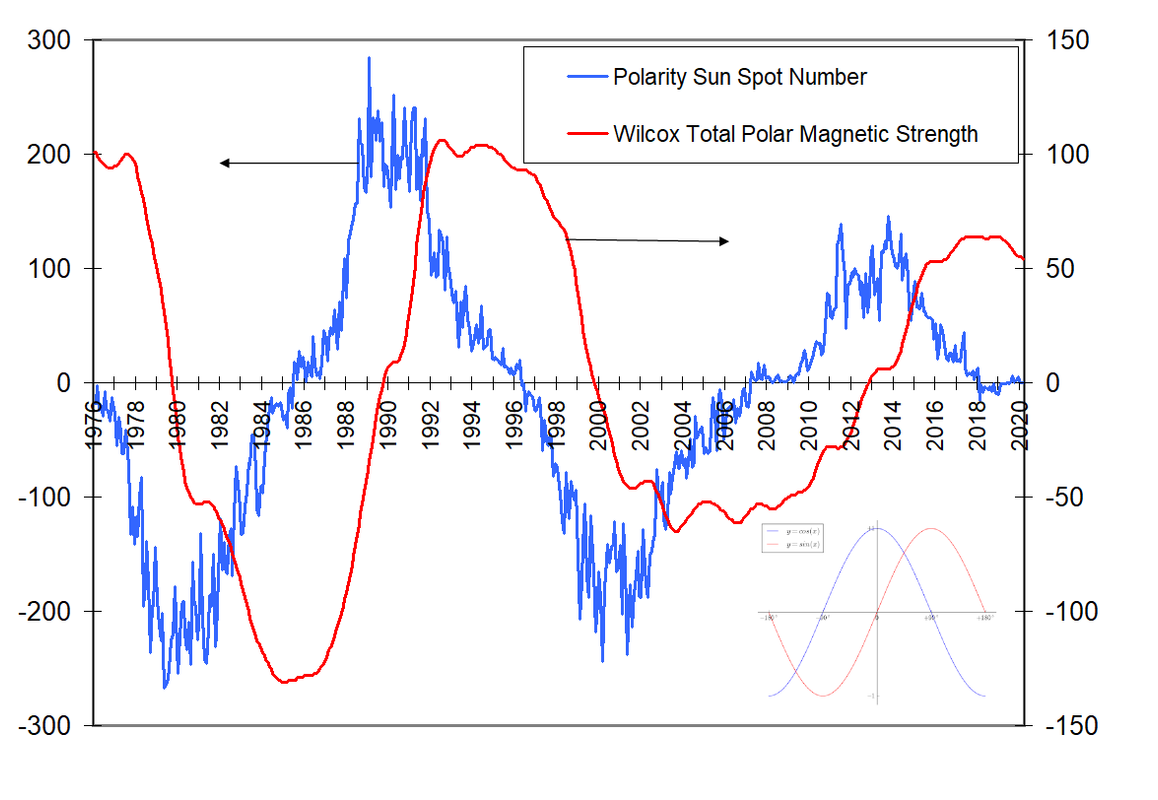
Polar field total seems to be dropping away quickly compared to pre-cycle24. Does that tell us anything in addition to peak amplitude of the cycle?
Perhaps this will answer your question. If the Sunspot/Magnetic field relationship is a temporal spatial one like the sine/cosine then perhaps the calculations and graphs below apply. Assuming that the Sunspot number varies as the differential of the magnetic field is the easiest calculation to do and the relationship should produce a straight line. The data is processed to a 24 month centered average to give a bulk result.
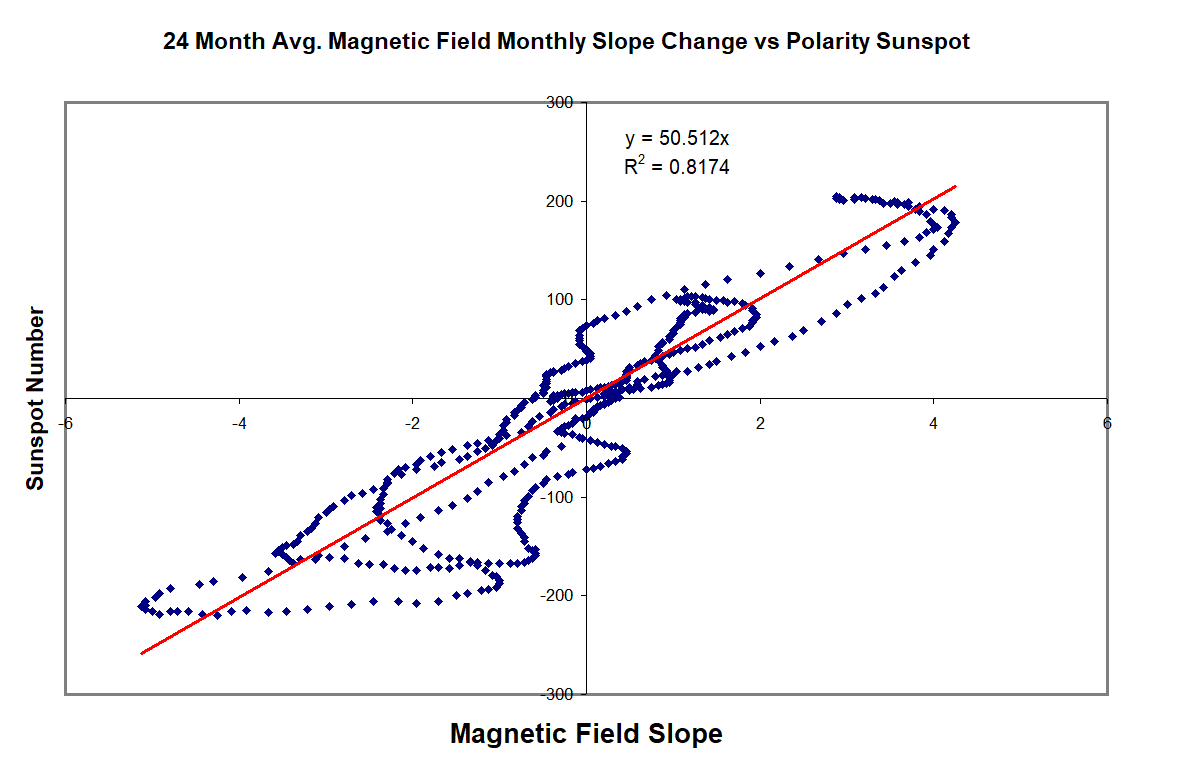
As you can see large changes in the magnetic filed produce high sunspot numbers. For the sunspot number to be low the magnetic field must fall away gradually. The graphic below is a recalculation of the historical sunspot number using the absolute value of the equation above and the actual 24 month magnetic field average.

A future projection of the sunspot number can be made by assuming a magnetic field and calculating the slopes. What to assume? I assumed that the Cycle 25 magnetic field strength would probably approach zero in a manner similar to Cycle 24. The graphic below shows the projection with this assumption producing a Cycle peak in 2025 of 73. It has to be something close to this because any significant deviation (steeper or more shallow) produces sunspot numbers which would astound sun watchers.

The other relationship of calculating the sunspot number from the sunspot differential time change versus the magnetic field strength requires an integration to get the sunspot number back. I will post that one later. I have run out of time for now.
Below is a plot of the monthly change in the 24 month average of the sunspot number versus the 24 month average of the solar magnetic field strength. The straight line fit is not great but usable. If there is a sine/cosine type relationship then the derivative of the sunspot curve should be a straight plotted against the magnetic field.
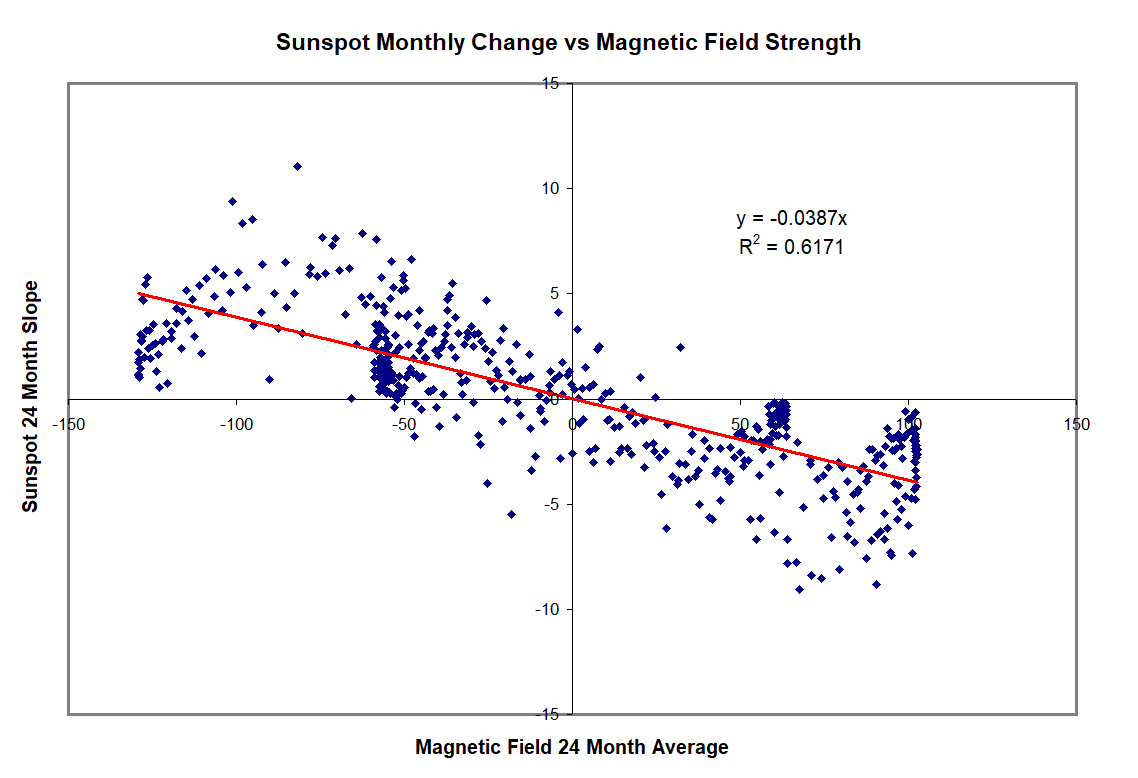
To recover the Sunspot curve from the straight line relation in the graph above requires calculating the slope from the magnetic field and integrating the result. The absolute value plus an integrating constant for a best fit is shown in the graphic below.
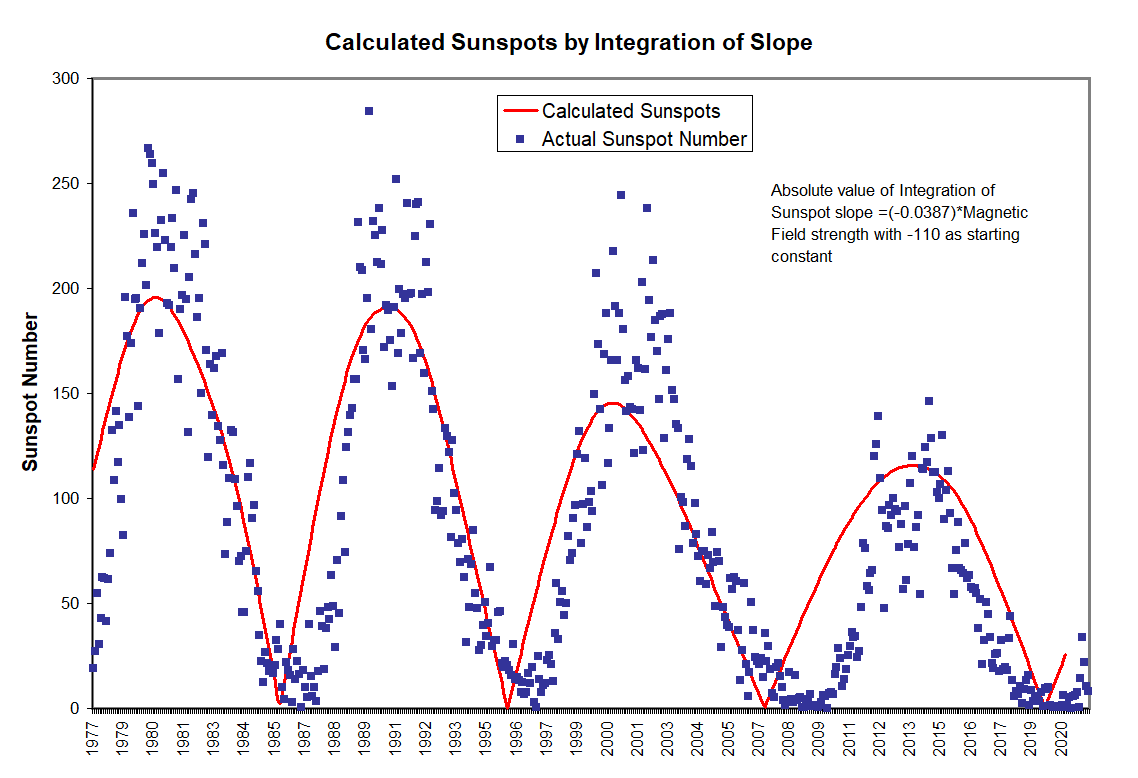
The projection of the sunspot curve from this relationship using the same magnetic field assumption of the decline in Cycle 24 produces the result below.
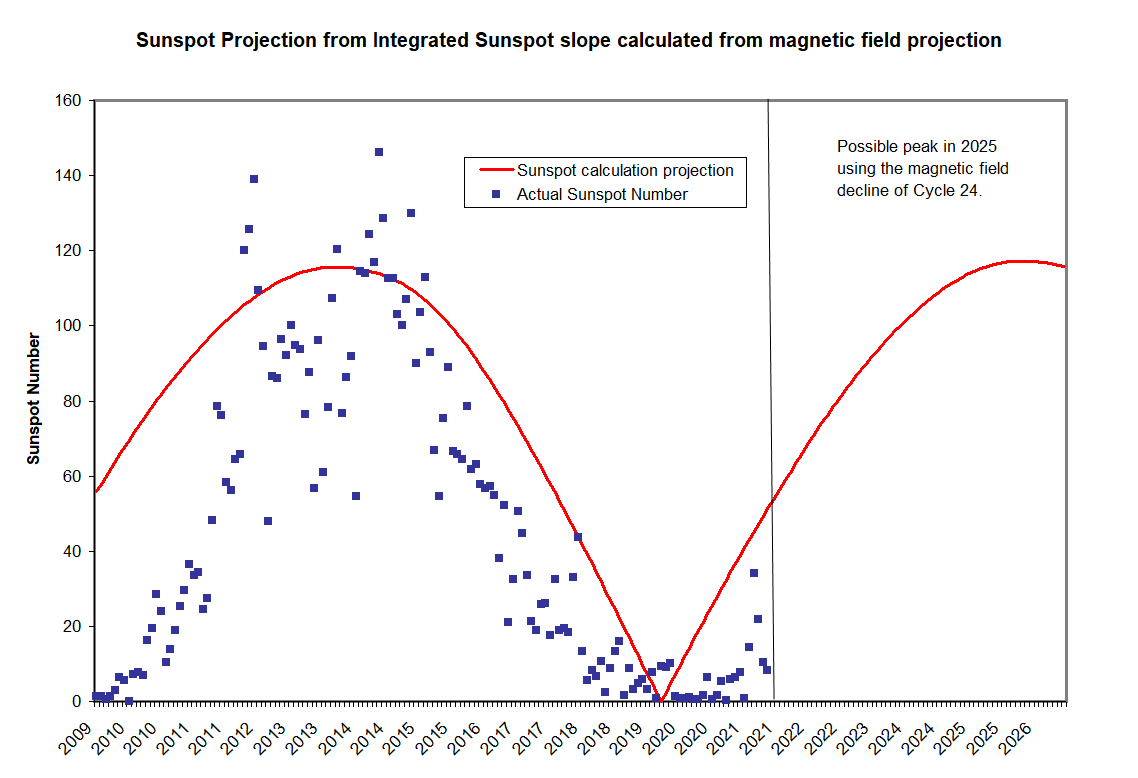
And just to finish this, below is the average of the two calculations.
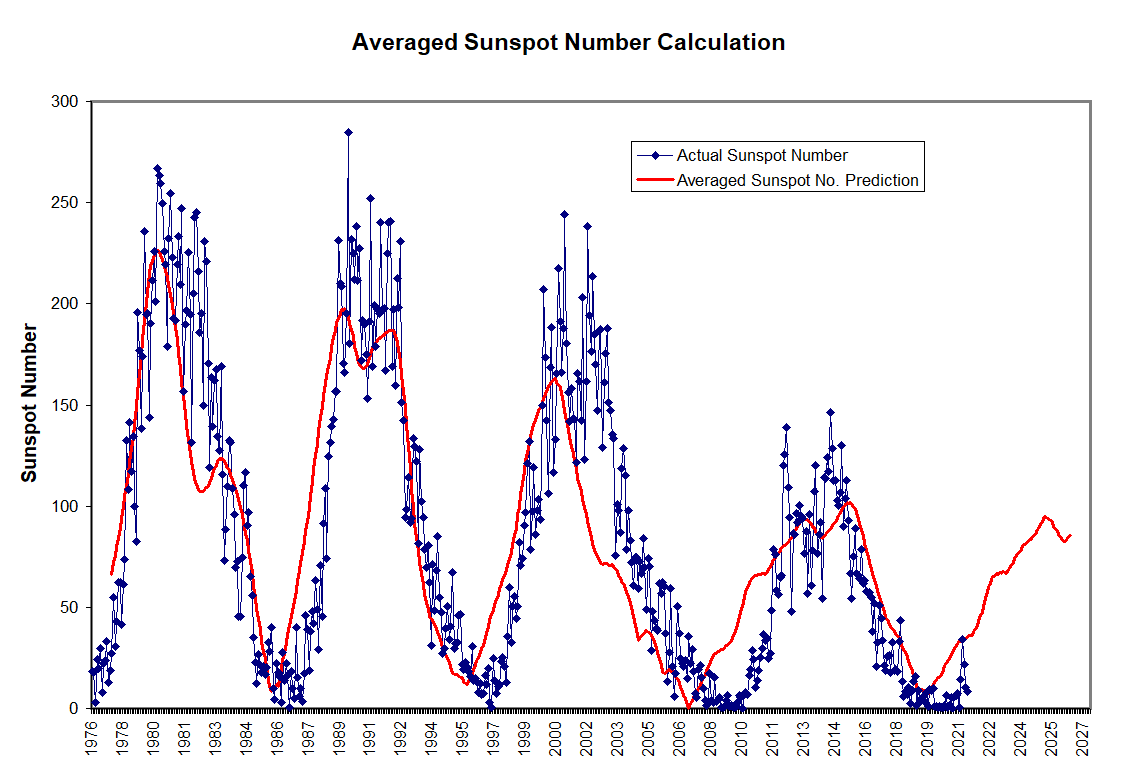
A succinct derivation Aequitas, however, your last plot (at 5:50) shows SC25 greatly exceeding 73, contradicting what you said before, “it has to be close to 73.” Why is that?
In the last plot, you’ve confirmed Svalgaard’s original peak prediction of at or slightly higher than SC24.
“This is useful because it puts a limit on the near future sunspot number unless the magnetic field does something completely strange.”
Solar mean-field variations also limit TSI and SST changes – no runaway solar warming.
Solar cycle 25 will want to peak in 2025 when the Earth-Venus inferior conjunctions are more in line with Neptune, and Jupiter is roughly in quadrature with Neptune. And I reckon that it will have a second peak when Earth-Venus and Jupiter repeat that arrangement with Uranus in 2027.
After that it’s back to the stronger roughly 10.4 year long Uranus based cycles until the next centennial solar minimum from the mid 2090’s, which will be the start of a new grand solar minimum series, which occur every 863 years (+/- 20yrs).
Cycle 26 though is the same type as cycles 20 and 16, where Jupiter is in inferior conjunction with Uranus at sunspot maximum rather than in superior conjunction or quadrature, so sunspot numbers will be lower, but the solar wind will be stronger than in cycles 24 and 25.
The next two centennial solar minima are very good analogues of the pair of super solar minima from 1360 BC and 1250 BC which collapsed most civilisations at the time, the period which many mistakenly call the Minoan Warm Period on the GISP2 ice core proxy.n A rather comical rewriting of history through not realising that Greenland is warmer during centennial solar minima.
.
The averaged sunspot graph was not posted? Stuck in moderator filter?
[mod] yes, retrieved now
And to conclude this exercise below is the average of the two calculations of the sunspot number from the solar magnetic field.

The last graph from Aequitas looks interesting and agrees with my 2010 paper. SC24 and SC25 should be very similar to SC5/6. What will be more interesting to me is SC26 which will see a solar recovery if my theory is correct.
Let’s enjoy SC25 while it’s here. Thank you all for your contributions in this discussion so far.
Assuming the temporal spatial relationship described above holds the future of Cycle 25 to enjoy will depend on how the magnetic field changes and the resulting steepness. Below are two comparisons in absolute values of the magnetic fields of Cycle 25 compared to Cycle 24 for your amusement.
